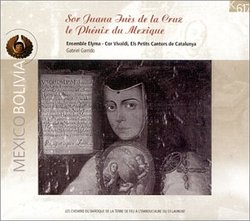| All Artists: Alejandro Meerapfel, Furio Zanasi, Anonymous, Juan de Araujo, Roque / Mesa, Manuel de Ceruti, Andres Flores, Manuel Mesa, Antonio Duran de la Motta, Blas Tardio y Guzman, Gabriel Garrido, Fabian Schofrin, Martin Oro, Elyma Ensemble, Ensemble Elyma, Alicia Broges, Adriana Fernandez, Rosa Dominguez Title: Sor Juana Inès de la Cruz: Le Phénix du Mexique Members Wishing: 1 Total Copies: 0 Label: K617 Records France Release Date: 4/9/2002 Album Type: Import Genres: Alternative Rock, Pop, Classical Styles: Vocal Pop, Opera & Classical Vocal, Chamber Music, Historical Periods, Baroque (c.1600-1750), Classical (c.1770-1830) Number of Discs: 1 SwapaCD Credits: 1 UPCs: 3383510001222, 713746259921 |
Search - Alejandro Meerapfel, Furio Zanasi, Anonymous :: Sor Juana Inès de la Cruz: Le Phénix du Mexique
 | Alejandro Meerapfel, Furio Zanasi, Anonymous Sor Juana Inès de la Cruz: Le Phénix du Mexique Genres: Alternative Rock, Pop, Classical
|
Larger Image |
CD Details |
CD ReviewsJust incredible... Maddy Evil | London, UK | 05/22/2005 (5 out of 5 stars) "*** PLEASE NOTE!! At the time of writing this review, this recording - as is unfortunately the case with many others by Ensemble Elyma - is becoming increasingly difficult to come by in the USA; however, it is worth checking the other amazon sites, especially for France and the UK, since it is usually not quite as impossible to obtain (and sometimes cheaper too!)...***
This programme, conceived jointly by Ensemble Elyma and the musicologist Bernardo Illari (UNT College of Music), draws together some of the works by composers working in the 'Real Audiencia de Charcas' (i.e. the 'Viceroyalty of Peru') which use texts taken from the villancico collections of Sor Juana Ines de la Cruz (1648-95). It focuses primarily on three composers - Juan de Araujo (1649-1712), 'maestro de capilla' at La Plata Cathedral from 1680-1712; Antonio Durán de la Mota (c.1675-1736), 'maestro de capilla' at Potosí; and lastly, the pure blood criollo Manuel (Fernandez) de Mesa (c.1725-1773), also 'maestro de capilla' at La Plata (1761-73). Overall, the selected villancicos give an excellent indication of the type of music which was heard in Bolivia (especially at La Plata) between c.1680 and c.1780. Although it is not confirmed in the liner notes (at least not in the reissue), the chosen works all seem to have been taken from the important collection of c.300 villancicos formerly owned by the musicologist Julia Elena Fortún, which was originally housed in the monastery of St Philip Neri (Sucre) and which is now kept in the Biblioteca Nacionales de Bolivia (Sucre). The performances are outstanding, which is hardly surprising given the personnel line-up (it comprises musicians who have performed with, amongst others, Hesperion XXI, the Gabrieli Consort, Concerto Italiano and L'Arpeggiata). Similarly, in contrast to many other recordings of this repertoire, the "ethnic" element is not overdone - percussion is only used on a few tracks, and furthermore, it is actually South-American (rather than African or Arabic). There is just one minor drawback concerning the 2001 reissue: song texts are not included (although a brief synopsis of them is provided). That said, their absence does not hinder the enjoyment of listening to this marvellous release. In all, you'd be hard pressed to find a better CD of New-World Baroque music in my view. If you haven't come across this group or this music before, this would be an excellent place to start! " |

 Track Listings (16) - Disc #1
Track Listings (16) - Disc #1